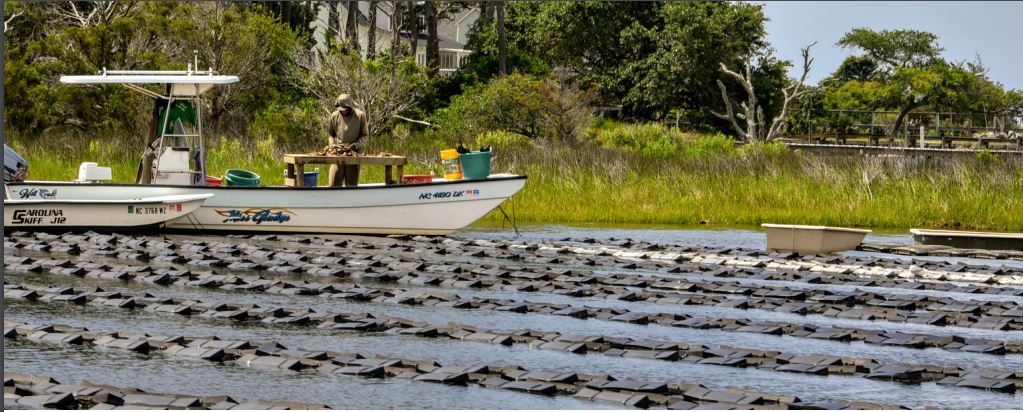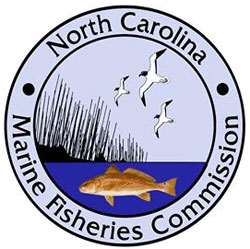
A recent feasibility study on North Carolina’s shellfish mariculture industry recommends building three regional business incubators in Onslow, Carteret and Hyde counties to serve as hubs for startup shellfish growers and kick-start growth.
Shellfish mariculture is the commercial farming of bivalve shellfish such as oysters, clams and mussels. With investment, there is potential to grow the shellfish industry well beyond its current $7.5 million in total economic activity, to a $100 million dollars by 2030, according to the study.
Supporter Spotlight
The proposed network of shellfish mariculture incubator facilities would include infrastructure to meet the needs growers identified in interviews for the study completed by the North Carolina Coastal Federation, with support from the U.S. Economic Development Administration and the Department of Commerce.
Based on information collected during the nearly 40 interviews with state shellfish growers and mariculture, seafood industry and economic development experts in 2019, top needs for the industry include investments in waterfront access, product storage, processing and distribution, and business services and training. Many of the comments by the interviewees were included in the study.
The proposed network of shellfish mariculture business incubators would address such needs and would initially support about 60 jobs. That’s about two for each of the 10 spaces that would be made available for rent in each incubator, according to the study.
Ryan Bathea, owner and operator of Oysters Carolina on Harkers Island, told Coastal Review Online Monday that having access to facilities like those proposed are critical for oyster growers.
“Having access to a landing or land-based infrastructure is important to an oyster farmer,” he explained, “If you don’t have that, you’re not going to be able to go far in the industry. There’s going to come a time you’ll need a landing.”
Supporter Spotlight
These proposed facilities “can help oyster farmers grow, and help new growers becomes successful,” he added.
A business-type incubator’s mission is to increase the development of emerging businesses in sectors supported by a state’s or region’s unique opportunities. “Incubators provide an environment that allow a region to take an active role in growing their own businesses that will lead to job creation and other economic impacts, including new tax generation,” the study states.
“Developing incubators is crucial to advancing North Carolina’s shellfish industry as they will improve growers’ chances of being successful in a very challenging business. They can help fill many voids that currently exist in our industry including infrastructure, water access, distribution, education, technology, and innovation,” said Chris Matteo the president of the North Carolina Shellfish Growers Association, in a statement.
The growers recommended the locations of the three facilities — Engelhard Marine Industrial Park in Hyde County, an 8.35-acre site owned by Carteret County and the federation’s Morris Landing Clean Water Preserve in Onslow County — all in counties with highest numbers of existing leases and total leased acreage.
Engelhard Marine Industrial Park is near Pamlico Sound. There are 44 leases in Hyde County and a law was passed last year that allows for three, 50-acre shellfish leases to be created there.
The incubator in eastern Carteret County could serve the 17 existing shellfish leases and a handful of pending applications, if approved, within a 45-minute drive of the site, and a good portion of the remaining 137 leases in the county.
The incubator in Onslow County, where there’s a total of 82 existing shellfish leases, could serve the 21 existing leases closest to the site, a half-dozen others that are pending approval and a portion of the 56 permitted leases in Pender County.
Waterfront access is an issue for many growers because of high property values, forcing many to rely on public launch and storage facilities, according to the study.
“No waterfront setup near the lease. That’s what will keep me from making it a scaleable business, the lack of the waterfront setup. Farmers that do this to some sort of scale have waterfront property where they can sort and tumble … That’s not feasible for most guys to have waterfront property,” an Onslow County shellfish grower said during his interview about waterfront access.
A Carteret/Pamlico County shellfish grower said during their interview, “There is a wildlife ramp (The Straits on Harker’s Island) but it’s a popular spot in spring, summer, fall. There’s also an overflow parking lot just off the bridge itself where you could temporarily unload gear and load boat. Not ideal as is. We are trying to get a floating dock permitted but how many people are going to spend $30k on a dock for a 2 acre lease that I lose a few years in a hurricane?”
Shellfish growers who use public launches and storage facilities often have to compete for space with other users, causing a challenge for growers to stay in compliance with strict rules for how long shellfish products can be out of the water before refrigeration.
“Oyster farming is easy but getting it off the farms and to the restaurants is the hard part. Harvesting, processing, tagging is hard…A more centralized distribution could help people. Everyone can’t afford the correct refrigeration. Multiple locations are needed,” an Onslow County shellfish grower said during their interview.
Those interviewed said that the “ideal facility” would have a loading ramp accessible by 16-foot and 18-wheeler trucks, cold storage and refrigeration/mechanical refrigeration, upwelling tanks for wet storage, pressure washing station and storm-ready infrastructure such as back-up generators.
The study points to shellfish growers needing access to business services such as assistance with financial capital acquisition and crop insurance like those land-based producers are eligible for, as well.Growers also need access to training and education regarding production technology and regulations, the study states. For example, Carteret Community College offers a one-year diploma in aquaculture technology, and began offering this summer a Shellfish Farming Academy.
“I attended CCC aquaculture program to decrease my learning curve. I’m a year 1 grower, no harvest yet. Going to school for a year helped me a lot. Knowing what tools to use, site selection, knowing who to talk to. I commercial fish: 60% commercial fish/40% shellfish farming. As the regulatory bodies put a squeeze on fishing, that number will continue to flip flop. I want to expand my business into finfish farming if everything works out,” a Carteret County shellfish grower said during their interview.
The study also found that the industry needs both state and community support to grow.







